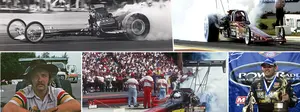

When pins were in
I used to have a really nicely organized garage. Really, I did. Stuff was where I put it and stayed there. My tools were all neatly organized, and I could always find the tool I needed. I could walk in and just smile at the neat racks of tools hung on the wall, sort through the old toolbox my dad gave me, or put something in the vise and cut it in half ... just because I could. I used to be pretty handy with tools back in my time.
Then came those pesky offspring. Soon, the garage was overwhelmed by bicycles and battery-powered ride-on cars and sports equipment and strollers and beach umbrellas, and old Easter baskets and ice chests began to take up residence on my once-proud workbench. The tools, like socks in the dryer, began to slowly disappear. It so depressed me that I put off a thorough cleaning for what seemed like decades, but last weekend, I decided that I would at least take a stab at straightening the workbench. Put all of those odds and ends and nuts and bolts and screws and wall anchors in their assigned little plastic drawers, restore some kind of order to the toolbox, and just generally clean up.
That was a really good plan. Then …
"Hey, what's in this beat-up brown Ace Hardware bag?"
And there went the rest of the day. For inside that tattered and torn bag that probably once left the store with electrical receptacles or toggle bolts was a handful of memories from the 1980s.
The 1980s brought the world a lot of new fads and trends, including New Wave music, Pac-Man, mullets, and legwarmers (hey, I didn't say they were good trends). For the drag racing world, it brought us go-fast goodies such as high-volume fuel pumps, lock-up clutches, tall Top Fuel wings, streamliners, and other high-tech gizmos that made drag racing that much cooler, but, for Joe Averages like me and you, those things were pretty much out of reach. The rest of us had cloisonné pins.
The little 50-cent-sized collectibles were huge in the early to mid-1980s. Pretty much any team or manufacturer of substance had its own and gave them to friends and associates. Mike Follmer parlayed his racing background and a huge circle of influence into a lucrative business, Mike Follmer Specialties (still in business today!), which did the lion's share of the production, but others also got in on the trend.
Every race, there was a newer, more trick design or idea, and the one-upmanship not just among the designers but the collectors, too, was stout. People would cover their hats with them or make up special display cases to show off their collections. Bidding and trading ran rampant in the pits. I never got into it too deeply, but I did stash away a few of them, which I'll show off below (which, I'm fairly certain, will unleash a tsunami of your own pics in my direction).
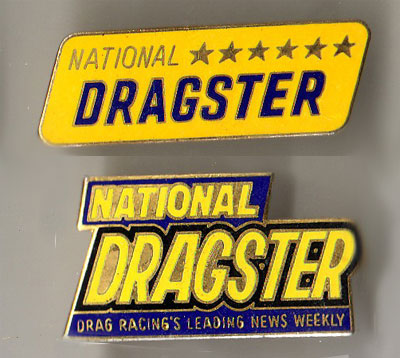 |
Of course, National DRAGSTER had to be part of the craze. During the years, we've made quite a few pins – we last made 50th anniversary pins – so the getting is still good for pin makers, but these were among the first. Although cloisonné refers generally to any decorated metalwork, these aren’t even really what I'd call cloisonné pins because they don’t have the single-pin/squeeze-open clasp but rather a simple hinged straight pin and locking mechanism.
They weren't as easy to put on your hat or shirt, but they seemed to stay better once you did – I don't know how many pins I lost because the back came off. The top one is the original we made, and it's interesting to me because of the stars. The traditional DRAGSTER logo has seven stars, which represent NHRA's seven divisions (betcha didn't know that!). This one only has six. Designer error? Nope. From 1980 through 1984, Divisions 6 and 7 were combined, so NHRA had six divisions (didja know that Graham Light, NHRA's senior vice president of racing operations, was the division director when Division 7 returned in 1985?), hence the six stars. That logo looks like no DRAGSTER logo that existed, so I'm not sure why we went with that design.
The second one is a more traditional National DRAGSTER logo (though not the current logo), and this design came with both a blue background like this one (very rare) as well as a yellow background. We eventually went away from this logo, which was around for years, because (so the story goes), it's not really made from any particular typeface but was created from scratch, making it harder for us to edit and use in other applications.
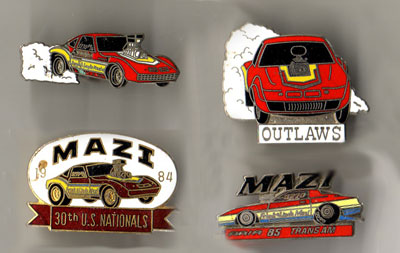 |
This next foursome comes from that familiar Eastlake, Ohio, family of mine, the Mazis. They were pretty pin crazy it seems. Their supercharged Opel was a fan favorite, so it comes as no surprise that their pins were pretty popular, too. I had an inside source or two, so I always was in on the ground floor.
I really like the pin at top left because it's silhouetted, right down to the burnout smoke. A lot of the car/team pins were the car on an oval or round pin, but before long, they all were like this. This, of course, is that famous early-Chrysler-powered Opel (driven not particularly well but nonetheless famously by yours truly). The look is just right, all the way down to the injector scoop and Frank's 3270 permanent number on the side window. The Opel also was the subject of other pins -- the one below it was a special edition created in honor of the 30th annual U.S. Nationals (1984), and the other, at top right, honors the Supercharged Outlaws racing group, of which the Mazis were founding members. A whole lot of good racers, including people like future Funny Car star Dean Skuza, competed in the Outlaws series, which ran primarily in the Midwest and Northeast and included altereds and, later, Funny Cars.
The final pin is the family's Trans Am, which replaced the aging but faithful Opel in 1985. The Opel was around long before I was, but I saw a lot of the Trans Am go together in my frequent trips to Ohio. I was there in Norwalk when it made its maiden voyage and ended up kissing the guardrail at the top end, for which I've always felt a little responsible. The car was not launching real well, and Frank was getting a little frustrated, and I remember advising him something stupid like, "Well, after you lift, just get back into it, and we'll see how she runs at the other end." Not that he would listen to me, but he did pedal 'er the next run, got loose, and spun 'er around at the top end. The car ended up parked driver's side into the opposite-lane guardwall, scuffed up but not badly damaged, but Frank couldn't get out. Linda was so mad at him that I remember she didn't even let him out of the car. She just hooked the tow strap on it and hauled him back to the pits. Yeah, that was a long, quiet ride home.
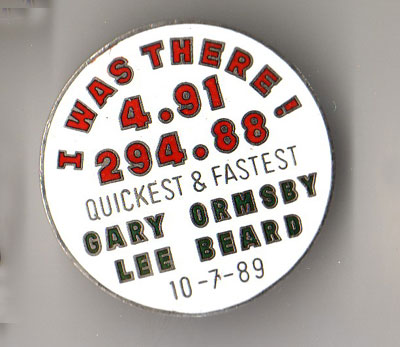 |
I'm not sure who came up with this idea – I think it was drag racing journo vet Jon Asher – but these became a little trend of their own: The "I was there" pin. This one is from the 1989 Chief Nationals at Texas Motorplex, and, yes, I was there. Even though it was just the event's fourth year there, we all knew what the Motorplex could do, yet Gary Ormsby and crew chief Lee Beard blew us all away by setting both ends of the national record in Top Fuel at 4.91, 294.99 en route to winning the event and boosting Ormsby's bid for what would be his only season championship. The 4.91 came in qualifying and led to a first of its own: four straight four-second runs in eliminations (remember, the four-second barrier had only been broken 18 months earlier at the Motorplex). The Top Fuel field tied the quickest show ever with a 5.141 bubble, equaling the mark established earlier in the year at the U.S. Nationals. Six of the 16 cars qualified in the fours, also a record.
A similar pin also was made for this event that celebrated Ed "the Ace" McCulloch's national-record-setting 5.13 in Funny Car. I have one somewhere. Probably sitting next to that long-lost 9/16th open-end wrench I can't find.
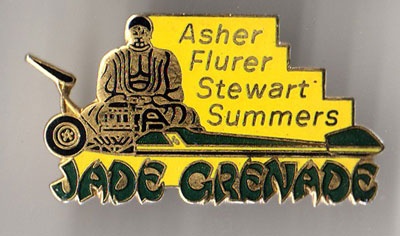 |
Asher definitely was in on this pin, saluting the Jade Grenade Top Fueler in which he was a partner in the 1970s. How, you might ask, does one go from being a writer/photographer covering our sport to part co-owner? Asher first became involved with the team – then owned by Bill Flurer, Pete Lenhoff, and driver Ted Thomas – doing public relations work. After Lenhoff and Thomas had to leave the team due to familial commitments, Sarge Arciero joined as the new driver/partner, and Asher was asked to be a partner (he already was a dollar donor to the car; see his funny Car Craft magazine story here). Dave Stewart and Cindi Summers later joined the team (hence Asher-Flurer-Stewart-Summers; Asher either got first billing alphabetically or because he designed the pin?).
There were lots of tough times and a few good ones – like being named Best Appearing Car at the 1975 Gatornationals and setting low e.t. of the whole damned 1974 U.S. Nationals, with a 6.01 in round one – and the whole thing came to a terrible end in 1975 when Don Roberts crashed the car. Roberts, a regular reader of this column, was horribly hurt in the accident that destroyed the Grenade, yet still is remembered for his wonderfully humorous quote about the accident: "It wasn't a bad run, but after the third flip, I lost control. ..." That quote is No. 37 on a list of the Top 50 auto racing quotes that can be found all over the Internet.
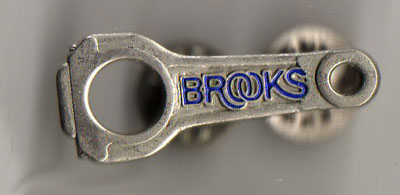 |
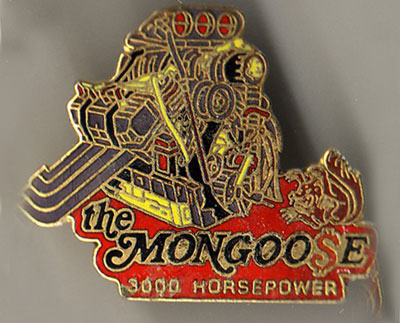 |
Even the manufacturers in the drag racing game got in on the pin craze, and this is one of my favorites. Brooks Rods (then owned by Bob Brooks, of AFT clutches fame) created this cool-looking connecting-rod pin, complete with the hole for the crankshaft and simulated rod bolts.
The only uncool thing about this pin is that it has two clasps, as you can see. Not really sure why that is because it's certainly smaller and lighter than any other pin. But because the claps are worn on the inside, other than gouging your skin twice, no one else could tell its construction.
This is one of my all-time favorites. Tom "the Mongoose" McEwen didn't put his car on his pin alongside his famously fearsome-looking rodent; he put an incredibly detailed nitro-burning Hemi engine. I mean, magneto, coil, spark-plug wires, all plumbing … it’s a beauty. I get a kick out of the "3,000 horsepower" tag, which must have seemed like a lot back then (I want to say this was 1985).
For years, no one was really sure just how much power a nitro engine made, so we used some pretty basic formulas to deduce it. I'm not sure if 3,000 was right for the time, but it seems a little low. People today still fuss and fight about whether 8,000 horsepower is high or low for today's nitro mills.
I got this pin at a special media-only dinner that McEwen threw just before the Winternationals. "The 'Goose" was always good to the media and threw us this little bash in the San Fernando Valley that got an all-star turnout of scribes and, I'm sure, earned him a lot of goodwill and future publicity. (See, it's still paying off 25 years later!)
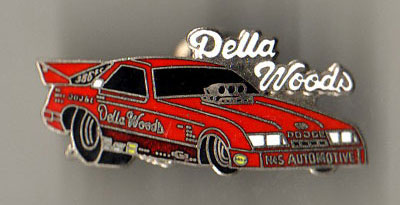 |
And, finally, in what will be a superb segue into my next item, here's a swell pin from Della Woods, showing her Dodge Daytona Funny Car. Like the Mazi Opel pin, I like this one for how the car is silhouetted as well as her name. Looking at this pin through a magnifying glass, it's amazing the detail that could go onto one of these things. It's not much bigger than an inch long (it's about half the size shown here), yet you can clearly read N&S Automotive on the front spoiler and her 386 permanent number on the side along with Dodge in several places. Woods, whose father worked at Dodge for 35 years, drove almost exclusively Dodge-bodied cars from her start in the late 1960s, the exception being her 1981 comeback car, the former Fighting Irish Trans Am.

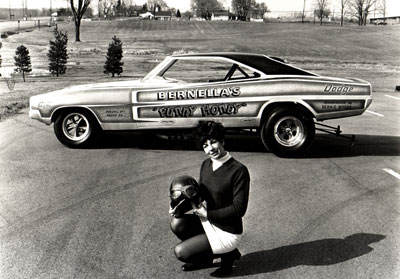 |
Woods is the subject of my Pure Nostalgia column this week in National DRAGSTER. I always liked Della when she was racing in the 1980s; she was always very nice to everyone, and we all rooted for her to do well (who could forget her scintillating run to the semifinals at the 1985 Reading event?). As one of the class' early pioneers who along with Paula Murphy and Shirley Muldowney in some small way helped make Ashley Force Hood and Melanie Troxel possible, I thought she deserved some love. She has been a Facebook friend for a while (and even plays Mafia Wars), so I used that to get in touch with her, and we have an interview scheduled for later today.
In the meantime, I was going through her photo file and found it not only crammed with great old pics like the one above but also several really well-produced press releases that taught me a lot about her.
Did you know that she used to run the dice table at the popular Chicago nightspot Fireplace but fortunately quit two months before the Chicago Police Department shuttered it? That she spent 300 hours with the John Robert Powers modeling agency "before deciding she enjoyed eating too much to achieve the cadaverous gauntness demanded in a high-fashion career"? That she was an actress at the Will-O-Way Theatre in Birmingham, Mich., where she acted in Shakespeare's Taming of the Shrew and Tennessee Williams' Glass Menagerie?
The press releases were kinda humorous in a Women's Lib way. Where today, drivers such as Force Hood, Troxel, and Erica Enders hardly play extensively on their gender, one of Woods' late-1960s press releases was headlined "Figure to watch when all-girl Della Woods races her Dodge Funny Car is her e.t. or mph." There also was a subheadline that read "Tip your hat and you may lose your shirt to this lass." (Classic.)
Or how about this: "Comely Della Woods of Pontiac, Michigan is a former model, actress, and clothes designer who turned many a man's head on the street. But it is luxury few males can afford when competing against her on the drag strip." Niiiiice.

On a more personal note, if I may, I'd like to say happy birthday to my son, Chris. Twenty-one years ago today, he came into this world, the son I always dreamed of having, and he's done nothing since then but live up to that expectation. He's a more decent human being than you'd expect to find in this graceless age, a good soul, honest and trustworthy with values that run deep and true. He's more than a son. He's a best friend and a confidant. We can talk sports or cars, or we can talk about girl problems. He made me proud by developing a deep love for my favorite non-racing sport – hockey – and we play together at least once a week in a competitive league. He's my all-star goalie – the best in the whole association – and I'm his bumbling defenseman, but none of that matters as much as doing it together. You all would be happy to have a son one tenth as kind and thoughtful as my Chris. Happy birthday, buddy. I love you.
OK, that's it for today. Gotta get set up for the interview. See ya later this week.



















































